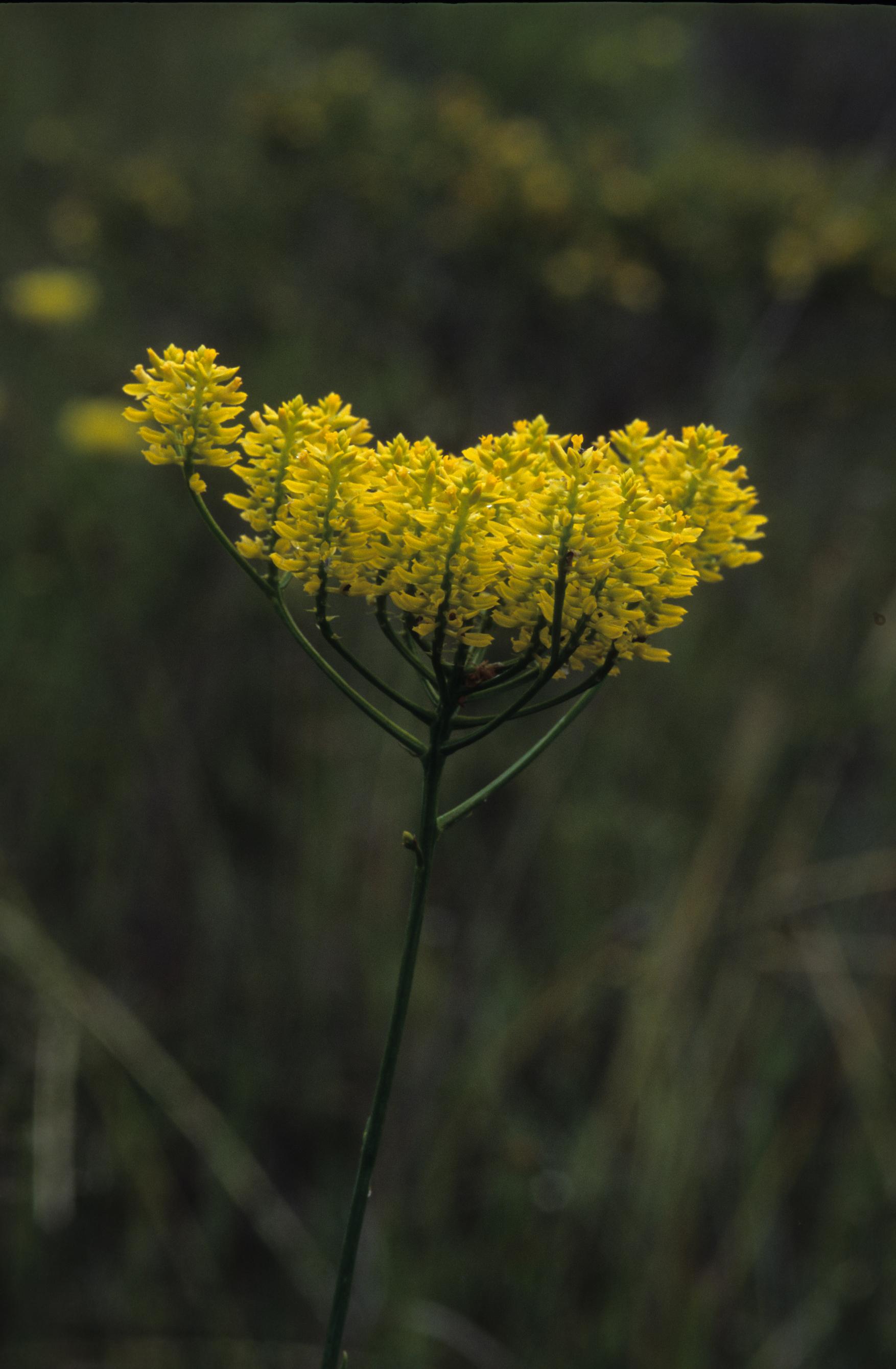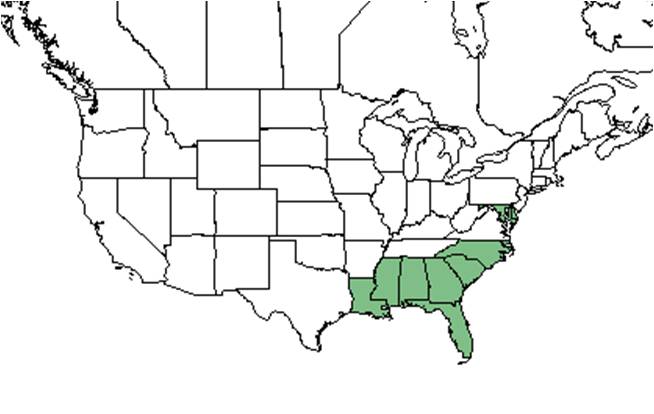Difference between revisions of "Polygala cymosa"
KatieMccoy (talk | contribs) |
HaleighJoM (talk | contribs) (→Ecology) |
||
| (22 intermediate revisions by 9 users not shown) | |||
| Line 20: | Line 20: | ||
Common name: Tall pinebarren milkwort | Common name: Tall pinebarren milkwort | ||
==Taxonomic notes== | ==Taxonomic notes== | ||
| + | Synonyms: ''Pilostaxis cymosa'' (Walter) Small; ''Pylostachya cymosa'' (Walter) Small | ||
| + | |||
==Description== | ==Description== | ||
<!-- Basic life history facts such as annual/perrenial, monoecious/dioecious, root morphology, seed type, etc. --> | <!-- Basic life history facts such as annual/perrenial, monoecious/dioecious, root morphology, seed type, etc. --> | ||
| − | "Herbs, whorled or alternate rarely opposite, entire leaves. Flowers lavender, pink, white or yellow, in racemes or spikes, terminating the branches or in terminal corymbs. Flowers perfect, zygomorphic, with 3 small sepals, frequently one of these slightly larger than the others, and 2 larger petaloid sepals (wigs). The 3 petals are united into a tube, 3-lobed at apex, the 2 lateral lobes usually the longer, the center lobe usually lacerate, often thicker in texture; stamens 6-8, united to the corolla tube in 2 rows. Capsule 2 –locular, with one seed in each locule. Seeds dark brown or black, ellipsoid or ovoid, rarely globose, 0.5-3 mm long, usually densely pubescent. The genus has been divided into several genera none of which have distinct characteristics. Orange flowers turn pale yellow on drying, yellow ones bluish green; the pink or lavender ones remain the same color or fade slightly." | + | "Herbs, whorled or alternate rarely opposite, entire leaves. Flowers lavender, pink, white or yellow, in racemes or spikes, terminating the branches or in terminal corymbs. Flowers perfect, zygomorphic, with 3 small sepals, frequently one of these slightly larger than the others, and 2 larger petaloid sepals (wigs). The 3 petals are united into a tube, 3-lobed at apex, the 2 lateral lobes usually the longer, the center lobe usually lacerate, often thicker in texture; stamens 6-8, united to the corolla tube in 2 rows. Capsule 2 –locular, with one seed in each locule. Seeds dark brown or black, ellipsoid or ovoid, rarely globose, 0.5-3 mm long, usually densely pubescent. The genus has been divided into several genera none of which have distinct characteristics. Orange flowers turn pale yellow on drying, yellow ones bluish green; the pink or lavender ones remain the same color or fade slightly."<ref name="Radford et al 1964">Radford, Albert E., Harry E. Ahles, and C. Ritchie Bell. Manual of the Vascular Flora of the Carolinas. 1964, 1968. The University of North Carolina Press. 660. Print.</ref> |
| − | "Similar to P. ramose. Stems usually solitary from a rosette, 4-12 dm tall. Basal leaves lanceolate to linear, 4-7 cm long, 3-7 mm wide, rapidly reduced upward. Sepals rounded to an abrupt acute apex, wings oblanceolate to nearly spatulate, 3-3.5 mm long; corolla with 2 clavate lobes at the apex equaling the wings. Seeds purplish black to grayish brown, glabrous and finely reticulate, ovoid, 0.6-0.8 mm long; aril obsolete." | + | "Similar to P. ramose. Stems usually solitary from a rosette, 4-12 dm tall. Basal leaves lanceolate to linear, 4-7 cm long, 3-7 mm wide, rapidly reduced upward. Sepals rounded to an abrupt acute apex, wings oblanceolate to nearly spatulate, 3-3.5 mm long; corolla with 2 clavate lobes at the apex equaling the wings. Seeds purplish black to grayish brown, glabrous and finely reticulate, ovoid, 0.6-0.8 mm long; aril obsolete."<ref name="Radford et al 1964"/> |
==Distribution== | ==Distribution== | ||
| − | ''P. cymosa'' is found throughout the southeast coastal plain from North Carolina to Louisiana<ref name="hawthorn">[[http://hawthornhillwildflowers.blogspot.com/2015/08/tall-milkwort-polygala-cymosa.html]] Native Florida Wildflowers. Accessed: February 21, 2016</ref>. | + | ''P. cymosa'' is found throughout the southeast coastal plain from North Carolina to Louisiana.<ref name="hawthorn">[[http://hawthornhillwildflowers.blogspot.com/2015/08/tall-milkwort-polygala-cymosa.html]] Native Florida Wildflowers. Accessed: February 21, 2016</ref> |
| + | |||
| + | ''Polygala cymosa'' is endemic to an area from southeastern New Jersey and Delaware to eastern North and South Carolina, but there is a disjunction between the Carolinas and New Jersey-Delaware.<ref>Sorrie, B. A. and A. S. Weakley 2001. Coastal Plain valcular plant endemics: Phytogeographic patterns. Castanea 66: 50-82.</ref> | ||
==Ecology== | ==Ecology== | ||
===Habitat=== <!--Natural communities, human disturbed habitats, topography, hydrology, soils, light, fire regime requirements for removal of competition, etc.--> | ===Habitat=== <!--Natural communities, human disturbed habitats, topography, hydrology, soils, light, fire regime requirements for removal of competition, etc.--> | ||
| − | + | ''P. cymosa'' is an obligate wetland plant and occurs in habitats such as cypress depressions, pine flatwoods, and depressional wetlands.<ref name=FSU Herbarium">Florida State University Robert K. Godfrey Herbarium database. URL: [http://herbarium.bio.fsu.edu http://herbarium.bio.fsu.edu]. Last accessed: November 2015. Collectors: Bob Fewster, Robert K. Godfrey, Marc Minno, R.A. Norris, Cecil R. Slaughter. States and Counties: Florida: Flagler, Franklin, Gilchrist. Compiled by Tall Timbers Research Station and Land Conservancy.</ref> Associated taxa include ''Aristida, Hypericum, Dichromena, Sarracenia, Drosera, Eriocaulon'', and ''Pinguicula.''<ref name="dep">[[http://www.dep.state.fl.us/water/wetlands/delineation/featuredplants/polcym.htm]] Department of Environmental Protection. Accessed: February 21, 2016</ref> | |
| − | |||
| − | |||
===Phenology=== <!--Timing off flowering, fruiting, seed dispersal, and environmental triggers. Cite PanFlora website if appropriate: http://www.gilnelson.com/PanFlora/ --> | ===Phenology=== <!--Timing off flowering, fruiting, seed dispersal, and environmental triggers. Cite PanFlora website if appropriate: http://www.gilnelson.com/PanFlora/ --> | ||
| − | + | ''P. cymosa'' has been observed flowering April through July and in September with peak inflorescence in April.<ref name="dep"/><ref>Nelson, G. [http://www.gilnelson.com/ PanFlora]: Plant data for the eastern United States with emphasis on the Southeastern Coastal Plains, Florida, and the Florida Panhandle. www.gilnelson.com/PanFlora/ Accessed: 12 DEC 2016</ref> | |
===Seed dispersal=== | ===Seed dispersal=== | ||
| − | ===Seed bank and germination=== | + | Seeds have an elaiosome, therefore the seeds are dispersed by ants.<ref name="treasure">[[https://treasurecoastnatives.wordpress.com/tag/polygala-cymosa/]] Treasure Coast Natives. Accessed: February 21, 2016</ref> |
| − | ===Fire ecology=== <!--Fire tolerance, fire dependence, adaptive fire responses--> | + | <!--===Seed bank and germination===--> |
| + | <!--===Fire ecology===--> <!--Fire tolerance, fire dependence, adaptive fire responses--> | ||
===Pollination=== | ===Pollination=== | ||
| − | + | ''Polygala cymosa'' was observed at the Archbold Biological Station to host leafcutting bees from the Megachilidae family such as ''Megachile brevis pseudobrevis''.<ref name="Deyrup 2015">Deyrup, M.A. and N.D. 2015. Database of observations of Hymenoptera visitations to flowers of plants on Archbold Biological Station, Florida, USA.</ref> | |
| + | <!--===Herbivory and toxicology===<!--Common herbivores, granivory, insect hosting, poisonous chemicals, allelopathy, etc--> | ||
| + | <!--===Diseases and parasites===--> | ||
| − | + | ==Conservation, cultivation, and restoration== | |
| − | == | + | ==Cultural use== |
| − | |||
| − | |||
| − | |||
==Photo Gallery== | ==Photo Gallery== | ||
<gallery widths=180px> | <gallery widths=180px> | ||
</gallery> | </gallery> | ||
| − | |||
==References and notes== | ==References and notes== | ||
| − | |||
| − | |||
| − | |||
| − | |||
| − | |||
Latest revision as of 10:08, 15 July 2022
| Polygala cymosa | |
|---|---|

| |
| Photo taken by Gil Nelson | |
| Scientific classification | |
| Kingdom: | Plantae |
| Division: | Magnoliophyta - Flowering plants |
| Class: | Magnoliopsida – Dicotyledons |
| Order: | Fabales |
| Family: | Polygalaceae |
| Genus: | Polygala |
| Species: | P. cymosa |
| Binomial name | |
| Polygala cymosa Walter | |

| |
| Natural range of Polygala cymosa from USDA NRCS Plants Database. | |
Common name: Tall pinebarren milkwort
Contents
Taxonomic notes
Synonyms: Pilostaxis cymosa (Walter) Small; Pylostachya cymosa (Walter) Small
Description
"Herbs, whorled or alternate rarely opposite, entire leaves. Flowers lavender, pink, white or yellow, in racemes or spikes, terminating the branches or in terminal corymbs. Flowers perfect, zygomorphic, with 3 small sepals, frequently one of these slightly larger than the others, and 2 larger petaloid sepals (wigs). The 3 petals are united into a tube, 3-lobed at apex, the 2 lateral lobes usually the longer, the center lobe usually lacerate, often thicker in texture; stamens 6-8, united to the corolla tube in 2 rows. Capsule 2 –locular, with one seed in each locule. Seeds dark brown or black, ellipsoid or ovoid, rarely globose, 0.5-3 mm long, usually densely pubescent. The genus has been divided into several genera none of which have distinct characteristics. Orange flowers turn pale yellow on drying, yellow ones bluish green; the pink or lavender ones remain the same color or fade slightly."[1]
"Similar to P. ramose. Stems usually solitary from a rosette, 4-12 dm tall. Basal leaves lanceolate to linear, 4-7 cm long, 3-7 mm wide, rapidly reduced upward. Sepals rounded to an abrupt acute apex, wings oblanceolate to nearly spatulate, 3-3.5 mm long; corolla with 2 clavate lobes at the apex equaling the wings. Seeds purplish black to grayish brown, glabrous and finely reticulate, ovoid, 0.6-0.8 mm long; aril obsolete."[1]
Distribution
P. cymosa is found throughout the southeast coastal plain from North Carolina to Louisiana.[2]
Polygala cymosa is endemic to an area from southeastern New Jersey and Delaware to eastern North and South Carolina, but there is a disjunction between the Carolinas and New Jersey-Delaware.[3]
Ecology
Habitat
P. cymosa is an obligate wetland plant and occurs in habitats such as cypress depressions, pine flatwoods, and depressional wetlands.[4] Associated taxa include Aristida, Hypericum, Dichromena, Sarracenia, Drosera, Eriocaulon, and Pinguicula.[5]
Phenology
P. cymosa has been observed flowering April through July and in September with peak inflorescence in April.[5][6]
Seed dispersal
Seeds have an elaiosome, therefore the seeds are dispersed by ants.[7]
Pollination
Polygala cymosa was observed at the Archbold Biological Station to host leafcutting bees from the Megachilidae family such as Megachile brevis pseudobrevis.[8]
Conservation, cultivation, and restoration
Cultural use
Photo Gallery
References and notes
- ↑ 1.0 1.1 Radford, Albert E., Harry E. Ahles, and C. Ritchie Bell. Manual of the Vascular Flora of the Carolinas. 1964, 1968. The University of North Carolina Press. 660. Print.
- ↑ [[1]] Native Florida Wildflowers. Accessed: February 21, 2016
- ↑ Sorrie, B. A. and A. S. Weakley 2001. Coastal Plain valcular plant endemics: Phytogeographic patterns. Castanea 66: 50-82.
- ↑ Florida State University Robert K. Godfrey Herbarium database. URL: http://herbarium.bio.fsu.edu. Last accessed: November 2015. Collectors: Bob Fewster, Robert K. Godfrey, Marc Minno, R.A. Norris, Cecil R. Slaughter. States and Counties: Florida: Flagler, Franklin, Gilchrist. Compiled by Tall Timbers Research Station and Land Conservancy.
- ↑ 5.0 5.1 [[2]] Department of Environmental Protection. Accessed: February 21, 2016
- ↑ Nelson, G. PanFlora: Plant data for the eastern United States with emphasis on the Southeastern Coastal Plains, Florida, and the Florida Panhandle. www.gilnelson.com/PanFlora/ Accessed: 12 DEC 2016
- ↑ [[3]] Treasure Coast Natives. Accessed: February 21, 2016
- ↑ Deyrup, M.A. and N.D. 2015. Database of observations of Hymenoptera visitations to flowers of plants on Archbold Biological Station, Florida, USA.